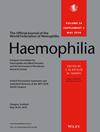Operationalising a Haemophilia Gene Editing Lexicon for Practical Use
Abstract
Introduction
Gene editing therapies offer the possibility of substantial improvement in treatment and quality of life for people with haemophilia (PWH) in a landscape of dynamic therapeutic advancement. Developing a common and understandable language to discuss gene editing will be essential to ensure these treatments can be deployed in a safe and effective manner with fully informed and shared decision-making between healthcare professionals (HCPs) and PWH. A lexicon explaining and clarifying key concepts is one potential tool to address these aims. Here we evaluate how a gene editing lexicon could be deployed to maximise impact and improve patient outcomes.
Aim
To operationalise the gene editing lexicon for successful adoption by the haemophilia community.
Methods
Through an innovative, iterative process, representatives from the haemophilia community, including multidisciplinary HCPs, PWH, and caregivers, with support from language strategy experts, developed a gene editing lexicon and evaluated operational aspects for real-world adoption of this resource.
Results
A gene editing lexicon was developed, including infographics illustrating key concepts. Infographics were adapted from the lexicon to further clarify and communicate these concepts. Infographics were found to be a potentially vital tool for enhancing the practical use of the lexicon to promote shared decision-making and attain informed consent for gene editing therapies.
Conclusion
A gene editing lexicon shows promise for improving the understanding of gene editing for all stakeholders in the haemophilia community. Ensuring the lexicon remains up to date with current therapies and appropriate strategies for adoption such as infographics will enable this resource to have maximum impact.

 求助内容:
求助内容: 应助结果提醒方式:
应助结果提醒方式:


